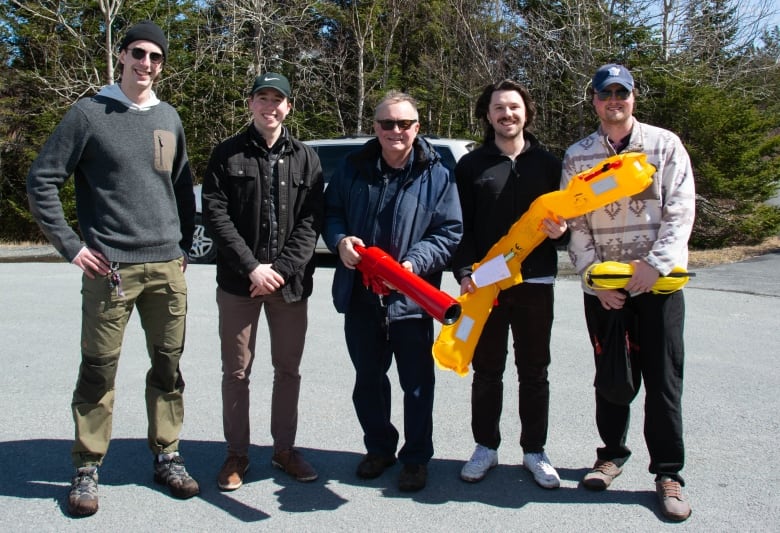Dalhousie students invent device to save lives at Peggys Cove
Prototype is designed to work in heavy winds, reduce risk to rescuers

The rocks around Peggys Cove's red and white lighthouse are picturesque, but they're also treacherous. Four people have died there in the last two decades. Once someone falls into the water, the strong current and powerful waves make rescues difficult.
Finding inspiration from a T-shirt cannon, a group of fourth-year mechanical engineering students at Dalhousie University have come up with a device to improve safety at one of the province's most well-known tourist sites.
Willem Glozanski and his classmates, Liam Carson, Zach Gould and Tanner Duplessis spent the last eight months developing a device that fires a life-preserver with a rope attached. When the rope is pulled, the preserver inflates.
"Going out to the water, firing it up at the rocks and having it work was probably my highlight," Glozanski said.

Paul D'Eon is the special projects director at the Lifesaving Society of Nova Scotia. The society funded the project and worked with the students as part of Dalhousie University's engineering capstone program, whichconnects students with professionals to solve real-world problems.
D'Eon said even highly experienced lifeguards won't go into the water at Peggys Covebecause the waves might crash them into the rocks.
Rescuers can get too close to the shore throwing a life-preserver, he said, leaving them at risk of winding up in the ocean too.
"The device had to be portable," D'Eon said. "It had to be user-friendly and it had to work in high winds and high waves."
It also had to be able to shoot a long distance and get to the drowning person within one minute, he said.
Glozanski said the prototype can cut through strong winds better than traditional ring buoys. That makes it more accurate, which can be crucial.
'The person in the water would have hope'
Zarin Mahesh Barot said he would be happy to see the life-saving device installed.
Last April, he fell into the water at Peggys Cove while trying to rescue his 23-year-old brother, Harshil. Fire crews rescued Zarin, but Harshil did not survive.
"At least the person in the water would have hope," Zarin said. "My life is a miracle, because there is nowhere that you can survive in those waters."

Last August, Build Nova Scotia added attendants to Peggys Cove as part of a new safety program. The attendants aren't lifeguards but they warn the public about nearby dangers and tell them if they're too close to the water.
Improvements needed
The students planned to install five of the life-saving devicesalong Peggys Cove's coast, along with a usermanual to make themmore accessible for anyone who may need to use them.
But D'Eon said the designstill requiresfurther improvements. Thelauncher material could be changed fromplastic to aluminum.Thebarrel may need to be longer.Inflating the life-preserver could be triggered with a remote control rather than a rope, he said.
A new group of students could make those improvements next year,D'Eon said, or else the life-saving society may hireprofessional engineers to do that work.
Depending on the costs and the amount of resources the society invests inthe project, D'Eon said it could be finished within three years.
The society has some fundingfor the project and willlook for additional financial support from government, he said.
"In an ideal world, no one would end up in the water," he said. "Unfortunately, some people do, and that's where the device would be useful."













_(720p).jpg)


 OFFICIAL HD MUSIC VIDEO.jpg)
.jpg)



























































































